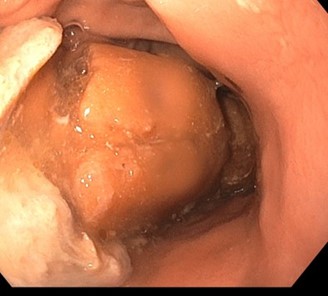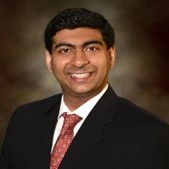
A 35-year-old White male with no significant medical history presented to the emergency room (ER) with a complaint of “I can’t swallow.” Approximately two hours ago, while eating chicken for dinner, he suddenly had trouble swallowing and a sensation of food being stuck. He could swallow saliva; however, he could not swallow solids or liquids. He felt a full sensation in his lower chest, with no other symptoms. In the ER, he was hemodynamically stable and had a normal O2 saturation. The physical examination was normal, and there were no signs of respiratory distress. He experienced a similar episode two years ago. At that time, the food “passed” after 15 to 20 minutes. No intervention was required. He has not undergone a previous GI evaluation. He has no medical problems and does not take any medication. He does not smoke tobacco. He has 4 to 6 alcoholic drinks per week.
The appropriate intervention to manage his esophageal food impaction is:
- CT scan of the chest and abdomen
- Barium esophagram
- Surgical consultation
- Upper endoscopy
The correct answer is D, upper endoscopy. This case only discusses food impaction in adults.
Practice Pearls
Epidemiology:
- The most common causes of esophageal food impaction in adults include esophageal stricture, eosinophilic esophagitis and Schatzki’s Ring.1 Less common causes of esophageal food impaction include tumors, achalasia and esophageal diverticula.1
- Most esophageal food impactions (80 percent) pass without the need for endoscopic intervention.2
- Up to 50 percent of patients with esophageal food impaction have eosinophilic esophagitis.1
Clinical Manifestations:
- The most common clinical presentation is the sudden onset of dysphagia.
- Additional symptoms include choking, refusal to eat, hypersalivation, retrosternal fullness and oral regurgitation of food and/or fluid.1
History and Examination:
- The history should include the time food was ingested, symptoms, previous history of food impaction and prior history of esophageal disease. When reviewing the history, it is important to include any prior EGD reports (and pathology results) and imaging such as esophagrams.
- The physical examination should include those of the oropharynx, neck, chest and abdomen, and is commonly unremarkable.
Evaluation and Management:
- Reserve evaluation with imaging for patients with suspected perforation or aspiration.
- Upper endoscopy is the test of choice for esophageal food impactions without signs of perforation or aspiration.1
- In patients with respiratory distress, endotracheal intubation may be required prior to endoscopy.
- Timing of upper endoscopy
- Emergent endoscopy—preferably within two hours and, at the latest, within 12 hours in patients with complete esophageal obstruction, as evidenced by drooling and an inability to handle oral secretions.1,2
- Urgent endoscopy—within 24 hours, if the patient is comfortable.1
- Therapeutic maneuvers for esophageal food impactions (images 1 and 2) include gently pushing the food bolus into the stomach using the endoscope and food bolus removal with grasping devices (forceps, snares, nets and baskets).1,2
- Using an endoscopic mucosal resection cap to suction and remove the bolus en bloc is effective, safe and efficient.1
- If an esophageal stricture or ring is identified after clearing a food bolus from the esophagus, dilation should be performed during the same session, provided there is no significant inflammation.1,2 Biopsies can also be obtained to assess for eosinophilic esophagitis in the same setting.
- Administration of glucagon (1 mg IV) can be attempted to relax the esophagus, which may promote passage of the food bolus.1,2 Glucagon is safe to use; however, its use should not delay endoscopic intervention.1
- After effective management of the esophageal food impaction, outpatient follow-up should be arranged for further evaluation and management of an underlying esophageal disease.
Image 1: Esophageal Food Impaction

From the personal library of Dr. Sumeet K Tewani, MD
Image 2: Esophageal Food Impaction

From the personal library of Sarah Enslin, PA
Authors
 Sumeet Tewani, MD, FASGE
Sumeet Tewani, MD, FASGE
Rockford Gastroenterology Associates
Rockford, IL
Sumeet Tewani, MD, FASGE, joined Rockford Gastroenterology Associates in 2014. He holds the title of clinical assistant professor of medicine, director of the gastroenterology curriculum, and serves on the Medicine Executive Committee at the University of Illinois College of Medicine in Rockford. He is currently a member of the ASGE Advanced Practice Provider Committee. Dr. Tewani’s scientific research has been published in national and international journals.
 Joseph Vicari, MD, FASGE
Joseph Vicari, MD, FASGE
Rockford Gastroenterology Associates
Rockford, IL
Joseph Vicari, MD, FASGE, joined Rockford Gastroenterology in 1997 and has served as managing partner. He previously served as chair of the ASGE Practice Operations Committee, a councilor on the ASGE Governing Board and is currently co-chair of the ASGE APP Committee.
 Sarah Enslin, PA-C
Sarah Enslin, PA-C
University of Rochester Medical Center
Rochester, NY
Sarah Enslin, PA-C, is a physician assistant at the University of Rochester Medical Center in Rochester, NY, with over 10 years of experience as a practicing PA in GI. Sarah serves on several national GI committees and is a former member of the ASGE Advanced Practice Provider Committee and a current member of the ASGE APP Committee.
References
- Triadafilopoulos G. Ingested foreign bodies and food impactions in adults. UpToDate. Updated October 11, 2023. https://www.uptodate.com
- ASGE Standards of Practice Committee. Management of ingested foreign bodies and food impactions. Gastrointest Endosc. 2011;73:1085-1091.